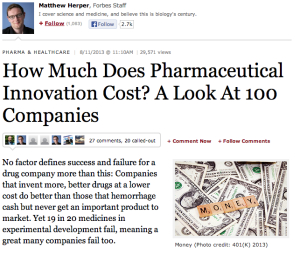 We applaud Matt Herper’s recent attempt to quantify pharmaceutical innovation. This has never been an easy number to calculate. In fact, much of the literature on drug development costs goes back to the late 1970s, when drug development cost data first started to become widely available via surveys. One of the classic papers in this field is the DiMasi, 2003 study (PDF), in which the first whispers of “one billion dollars per approved drug” started making their way into the press. The body of work from the DiMasi group is based on survey data collected over several decades. Now Matt Herper at Forbes took an admittedly cruder approach:
We applaud Matt Herper’s recent attempt to quantify pharmaceutical innovation. This has never been an easy number to calculate. In fact, much of the literature on drug development costs goes back to the late 1970s, when drug development cost data first started to become widely available via surveys. One of the classic papers in this field is the DiMasi, 2003 study (PDF), in which the first whispers of “one billion dollars per approved drug” started making their way into the press. The body of work from the DiMasi group is based on survey data collected over several decades. Now Matt Herper at Forbes took an admittedly cruder approach:
Last year, for the first time, I did something far cruder: I took the 15-year research spending of a group of big pharmaceutical companies and divided it by the number of new drugs (technically new molecular entities, the Food and Drug Administration’s term for drug molecules that have not been approved in any form for any use previously).
Now Herper himself (as well as many of the comments) point out that this method has a number of flaws:
- Companies such as Abbott and J&J also spend R&D monies on medical devices
- Some of the R&D spend likely goes towards non-development costs, such as safety monitoring post-approval
- It’s unclear how to factor in-licensed assets (and the money spent prior to the transaction)
There are other issues, such as looking at spending versus ROI, etc. Regardless, the analysis, while crude, does illustrate how difficult it can be, as outsiders, from truly understanding how much it costs to develop an approved drug. Also, what does this tell us about “Big Pharma” companies like Abbott, Sanofi, AZ, and Roche? Are they truly that inefficient? Or, are they simply pursuing higher cost/higher revenue indications? Did Abbott really spend $13 billion to develop one drug?
I find it quite interesting to scan the list of companies who have developed one or more approved drugs while keeping their costs at ~$1 billion or less, such as Cephalon ($1.2 billion), Forest ($1.3 billion), Dendreon ($0.5 billion), and others. I’m sure there are specific reasons for these lower costs, e.g., lower clinical development costs, lower corporate overhead, etc.
Hopefully others will take these data and take this interesting analysis even further.
Related articles





